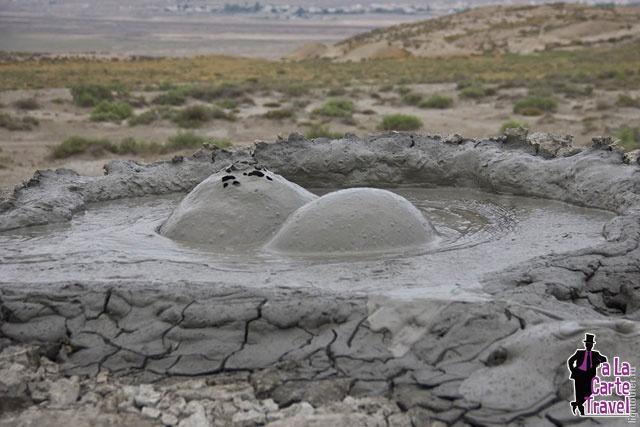Russian scientists to study mud volcanoes of Azerbaijan

By Mirsaid Ibrahimzade
Azerbaijan has more mud volcanoes than any other country, spread broadly across its territory. As many as 350 of the 800 volcanoes of the world are located in Azerbaijan. People call them “yanardagh” (burning mountain), “pilpila” (terrace), “gaynacha” (boiling water) and “bozdag” (grey mountain) alongside its geographical name – mud volcanoes.
The earthquakes that occurred recently in some areas of the country affected the activation of some volcanoes in Shamakhi and in the north of Gobustan, so Gushchu mud volcano erupted in Shamakhi region on February 5. The eruption first occurred in 1913, the last was in the past. Including the last eruption, Gushchu volcano has erupted 15 times over the past 200 years.
The world’s largest mud volcanoes - Boyuk Khanizadagh and Turaghai - are both in Azerbaijan. Boyuk Khanizadagh, the diameter and height of which are 10 kilometers and 700 meters respectively, erupted on October 10, 2001, shooting out flames for 300 meters in the air. It was the highest record for flames shot from a mud volcano.
Considering those facts, Azerbaijan National Academy of Sciences and Russian Academy of Sciences (RAS) have agreed to jointly study the biodiversity of islands, mud volcanoes of the Azerbaijani part of the Caspian Sea, migration routes of migratory birds, and also publish the international journal "Ecology of Animals in Eurasia", Trend reports referring to ANAS.
The agreement was reached within the framework of the scientific mission of Director of the Institute of Zoology of ANAS, Ph.D. in Physics Elman Yusifov, to the Institute of Plant and Animal Ecology at the invitation of the Director of the Institute M. Golovatin.
Russian scientists were invited to conduct joint multidisciplinary research, study the Caspian biodiversity, develop the Caspian fauna inventory, create an international laboratory, study the category and status of rare and endangered fauna species, compare the hydro fauna of the Ural and Kura rivers, study the phylogeny of the Caspian seal and Arctic seals, and jointly palezoological studies.
Touching upon Caspian Sea, it is vital to note that underground and submarine mud volcanoes are also famed in Azerbaijan. There are more than 140 submarine volcanoes in the Caspian Sea. Eight islands in the Baku Archipelago are mud volcanoes by origination. The other kind of mud volcanoes are wells. Their activity can be observed among strata of various ages. According to the information, mud volcanoes initially began their activity in the territory of Azerbaijan 25 million years ago.
In addition, there are several interesting facts about mud volcanoes in Azerbaijan.
NASA geologists studying Mars planet, concluded that mud volcanoes of Azerbaijan are similar to uplands of the planet for their structure.
On September 5, 2004 the biggest mud volcano in the territory of Azerbaijan was included into the Guinness World Records.
The mud volcanoes located in Gobustan National Park sights attract thousands of tourists annually.
The State Historical-Artistic Reserve has been functioning since 1967. In 2007, the reserve was included in the UNESCO World Heritage Sites list.
A trip to Gobustan gives you a great chance to see these amazing active volcanoes from very close distance.
Azerbaijan's rich fields of oil and gas condensate such as Lokbatan, Garadagh, Oil Rocks, and Mishovdag were also discovered near mud volcanoes.
The lava, mud, and liquid spewed by mud volcanoes are used as raw materials for chemical and construction industries, as well as pharmacology.
Enriched with specific components - mineral salts, organic substances, microelements, volcanic mud has medicinal properties that have a beneficial effect on the human body.
Volcanic mud gives a great effect in the treatment of patients suffering from diseases of the peripheral and central nervous system, gastrointestinal tract, skin, etc.
--
Follow us on Twitter @AzerNewsAz
Here we are to serve you with news right now. It does not cost much, but worth your attention.
Choose to support open, independent, quality journalism and subscribe on a monthly basis.
By subscribing to our online newspaper, you can have full digital access to all news, analysis, and much more.
You can also follow AzerNEWS on Twitter @AzerNewsAz or Facebook @AzerNewsNewspaper
Thank you!
